
A long time ago, before xxxHolic, before Chobits, even before Cardcaptor Sakura, the enigmatic team of artists known as CLAMP created a manga called Magic Knight Rayearth, which was made into a two-season television series, the first anime to be based on their work.
Perhaps because it was an early work the series has a strangely uneven tone. Watching the first season for the first time I initially felt amused, then impatient, and finally shocked. The second season seemed darker but more enjoyable. When I watched it for a second time I had a better idea of what the first season was really about and I enjoyed it a good deal more.
Actually once I accepted that there is more going on here than just a goofy parody I found the story powerful and affecting. If you are a fan of CLAMP’s other stories you will definitely want to see this one. On the other hand, if you have no previous exposure to CLAMP’s somewhat twisted sense of humor you would probably do better to start with one of their more accessible works, such as Cardcaptor Sakura or Angelic Layer.
-
Original TitleMajikku Naito Reiaasu
-
DemographicShoujo
-
GenresFantasy, Parody, Sword and Sorcery, Mecha, Tragedy
-
Contents49 episodes on 12 DVDs (2 boxed sets)
-
LanguagesJapanese with subtitles, English
-
Based onA manga by CLAMP
-
DirectorToshihiro Hirano
-
BroadcastYomiuri TV, 1994-1995
-
Region 1 PublisherAnime Works / Media Blasters
Synopsis
First Season, Episodes 1-20
The story seems to hit every common trope of shounen anime. Three heroes travel through a magic kingdom, slaying monsters with swords and magic spells, trying to level up to the point where they can rescue a princess. When they get tired of swords and sorcery they acquire some giant robots to stomp around in.
But something is wrong here. The heroes are actually girls in frilly dresses, and the magic land, aside from monsters, seems to be overstocked with pink unicorns and other fauna that would make any self-respecting shounen hero gag.
So this is actually a whimsical shoujo parody of the kind of stories that the boys like. Fair enough. But as the story progresses it seems to become increasingly dark. By the twentieth episode it has disconcertingly turned into a full-blown classical tragedy, causing the first season to end on a rather sour note.
Second Season, Episodes 21-49
Solitary tears fall into the sea that I sealed away inside my heart.
The bright light that I missed will not come back to me now,
So I want freedom, just like the wind that will come with the next sunrise.
I feel it trembling in the bottom of my heart:
Both the light and the darkness that I warmly embrace,
A chase for the dream that I just can’t give up on…
The second season contains some whimsical elements but the overall tone is darker than the first. Instead of a sword-quest through a beautiful magic land, we see giant robots battling in a desolate landscape for a prize that seems hardly worth having. Characters wrestle with their inner demons, sometimes literally.
Repeatedly this story arc threatens to end as tragically as the first, if not more so. Finally it works it way to a more-or-less happy ending.
Parental Advisory
This series is best suited for teenagers and adults. It doesn’t contain anything likely to be particularly harmful to younger children, but they probably will not enjoy it. Older viewers who have some experience with stories with tragic elements are more likely to appreciate it.
Children as young as seven might enjoy the whimsical opening episodes, but by the time they reached the end of the first story arc they would probably be confused or upset. The second season would probably be even less appealing.
The series includes numerous violent action sequences. The violence is stylized but not entirely bloodless, particularly in the later episodes. None of it would be likely to frighten a typical American ten-year-old.
Other Versions
A three-episode OVA (direct-to-video) was released in 1997. This uses the same character names and designs to tell a completely unrelated story. Since it has nothing to do with this story I won’t discuss it further here.
Premise and Characters
First Season
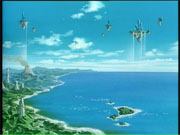 The world of Cephiro is known as “The Land of Will”. This means that if you wish for something hard enough it will come true. Also your fears can create real monsters.
The world of Cephiro is known as “The Land of Will”. This means that if you wish for something hard enough it will come true. Also your fears can create real monsters.
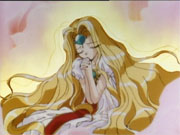 This sounds like an unstable arrangement, and indeed it is. Only the constant prayers of Princess Emeraude, the Pillar of Cephiro keep the land peaceful and safe.
This sounds like an unstable arrangement, and indeed it is. Only the constant prayers of Princess Emeraude, the Pillar of Cephiro keep the land peaceful and safe.
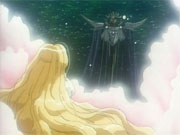 But now the Cephiro is in trouble. Princess Emeraude has been kidnapped by the fearsome and ruthless High Priest Zagato. Without the support of the Pillar things are beginning to fall apart. Monsters roam the land; storm clouds gather and the earth itself trembles.
But now the Cephiro is in trouble. Princess Emeraude has been kidnapped by the fearsome and ruthless High Priest Zagato. Without the support of the Pillar things are beginning to fall apart. Monsters roam the land; storm clouds gather and the earth itself trembles.
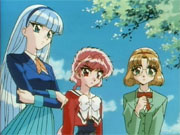 As one might well expect, what appears in answer to her call are three 14-year-old Japanese schoolgirls.
As one might well expect, what appears in answer to her call are three 14-year-old Japanese schoolgirls.
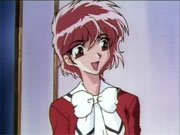 Hikaru Shidou is the smallest of the three. She looks much younger than her real age and is very naive. Apparently she has had a sheltered upbringing, but she is very cheerful, optimistic and brave. Her family runs a traditional martial arts school, and she has studied kendo or sword fighting.
Hikaru Shidou is the smallest of the three. She looks much younger than her real age and is very naive. Apparently she has had a sheltered upbringing, but she is very cheerful, optimistic and brave. Her family runs a traditional martial arts school, and she has studied kendo or sword fighting.
In Cephiro Hikaru develops the ability to use magic spells based on Fire.
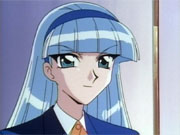 Umi Ryuuzaki attends an exclusive academy for the daughters of the nation’s political and business elite, where she has just been made captain of the (European-style) fencing team. She is very upset to find herself yanked into a strange new world. Although she acts snobbish and unfriendly at first, she quickly bonds with the others and gets with the program.
Umi Ryuuzaki attends an exclusive academy for the daughters of the nation’s political and business elite, where she has just been made captain of the (European-style) fencing team. She is very upset to find herself yanked into a strange new world. Although she acts snobbish and unfriendly at first, she quickly bonds with the others and gets with the program.
It turns out that Umi can use magic based on Water.
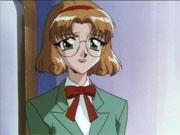 Fuu Hououji attends a special school for gifted children, where she is on the archery team. She speaks in a very formal, old-fashion manner, which is probably a sign of her scholarly disposition. She is usually sensible and level-headed.
Fuu Hououji attends a special school for gifted children, where she is on the archery team. She speaks in a very formal, old-fashion manner, which is probably a sign of her scholarly disposition. She is usually sensible and level-headed.
Fuu can use magic based on Wind. A kind soul, she prefers to use healing and binding spells but is prepared to use attack spells if necessary.
 The three are met by Master Mage Clef, a strange little dwarf who is the greatest wizard in the land, except, unfortunately, for Zagato. Clef only has time to give them a few pointers on what to do next before Zagato shows up and turns him into a stone statue.
The three are met by Master Mage Clef, a strange little dwarf who is the greatest wizard in the land, except, unfortunately, for Zagato. Clef only has time to give them a few pointers on what to do next before Zagato shows up and turns him into a stone statue.
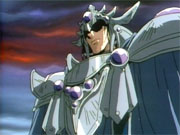 Clearly Zagato is one powerful character. Logically he ought to be able to crush the would-be Magic Knights like three little bugs. Fortunately for the Cause of Justice he seems to have read the page in the Evil Overlord’s Handbook where it says that when potential heroes show up you should send your lesser minions to deal with them first, and only go after them yourself if they defeat your minions (growing more powerful in the process).
Clearly Zagato is one powerful character. Logically he ought to be able to crush the would-be Magic Knights like three little bugs. Fortunately for the Cause of Justice he seems to have read the page in the Evil Overlord’s Handbook where it says that when potential heroes show up you should send your lesser minions to deal with them first, and only go after them yourself if they defeat your minions (growing more powerful in the process).
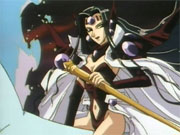 Alcyone is the first minion to be unleashed. A former student of Clef’s who betrayed him for the love of Zagato, she wields powerful ice magic.
Alcyone is the first minion to be unleashed. A former student of Clef’s who betrayed him for the love of Zagato, she wields powerful ice magic.
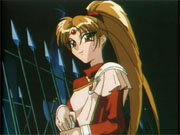 Magic Knights can’t do much without magic swords, so the three companions seek the help of Presea the Master Smith. She offers to make them appropriate weapons if they will go on a quest to obtain the necessary materials. Presea doesn’t look muscular enough to be a blacksmith. However in Cephiro it is possible to make swords by dancing around in a diaphanous gown, so that’s all right.
Magic Knights can’t do much without magic swords, so the three companions seek the help of Presea the Master Smith. She offers to make them appropriate weapons if they will go on a quest to obtain the necessary materials. Presea doesn’t look muscular enough to be a blacksmith. However in Cephiro it is possible to make swords by dancing around in a diaphanous gown, so that’s all right.
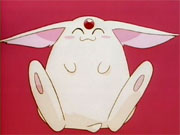 Mokona will guide them on their quest. Mokona is a fat, white rabbitty sort of thing who only says “puu”. He is not much good in a fight, but he can function as a combination GPS navigation system/video projector/supply trailer.
Mokona will guide them on their quest. Mokona is a fat, white rabbitty sort of thing who only says “puu”. He is not much good in a fight, but he can function as a combination GPS navigation system/video projector/supply trailer.
(I am presuming that Mokona is supposed to be male. The English subtitles refer to him that way. The Japanese is not much help, especially since he only says “puu”.)
Mokona is obviously supposed to represent Mokona Apapa, CLAMP’s lead artist. (She later changed her name to just “Mokona”.) The three Magic Knights are generally assumed to represent the other three members of CLAMP. Most of the other characters are named after cars for some reason.
 Ferio is some sort of mercenary. Or maybe a hunter. Or a wandering minstrel. Or a thief. It’s hard to be sure because he keeps changing his story. In any case he is clearly not to be trusted. Fuu seems to like him though.
Ferio is some sort of mercenary. Or maybe a hunter. Or a wandering minstrel. Or a thief. It’s hard to be sure because he keeps changing his story. In any case he is clearly not to be trusted. Fuu seems to like him though.
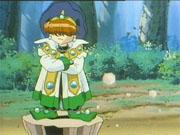 Ascot the Summoner is another of Zagato’s minions, a ruthless little brat who can summon huge, ugly beasts to do his bidding. If you kill the beasts he will be very upset because they are all his dear friends.
Ascot the Summoner is another of Zagato’s minions, a ruthless little brat who can summon huge, ugly beasts to do his bidding. If you kill the beasts he will be very upset because they are all his dear friends.
Ascot has a strange habit of mixing villainous gloating with childish speech patterns. “Ha ha ha! What stupid onee-chan (big sisters)!” he sneers.
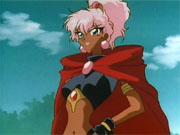 Caldina the Illusionist is yet another minion. She has no particular loyalty to Zagato; she expects to be paid for her work. Though obsessed with money she is very fond of little Ascot.
Caldina the Illusionist is yet another minion. She has no particular loyalty to Zagato; she expects to be paid for her work. Though obsessed with money she is very fond of little Ascot.
Caldina speaks with a heavy Osaka accent, which is considered comic in Japan. The producers of the English dub think this is equivalent to a very bad imitation of an American southern accent.
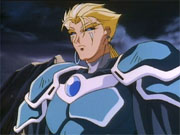 Lafarga is a “swordmaster”, which seems to mean that in his hands a sword becomes a weapon of mass destruction.
Lafarga is a “swordmaster”, which seems to mean that in his hands a sword becomes a weapon of mass destruction.
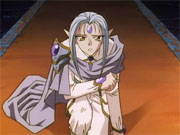 Inouva is Zagato’s most powerful and most devoted minion.
Inouva is Zagato’s most powerful and most devoted minion.
Second Season
 Lady Debonair is very evil, and looks the part.
Lady Debonair is very evil, and looks the part.
 Eagle Vision is the leader of a military expedition from Autozam, a high-technology world that is running out of energy.
Eagle Vision is the leader of a military expedition from Autozam, a high-technology world that is running out of energy.
 Geo Metro is Eagle’s second-in-command.
Geo Metro is Eagle’s second-in-command.
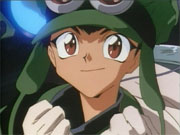 Zazu Torque is a young mechanic, responsible for maintaining the mechas used by the Autozam forces.
Zazu Torque is a young mechanic, responsible for maintaining the mechas used by the Autozam forces.
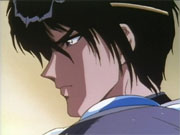 Lantis is a moody, brooding character who combines the abilities of wizard and swordmaster.
Lantis is a moody, brooding character who combines the abilities of wizard and swordmaster.
 Primera is an annoying little fairy who follows Lantis around.
Primera is an annoying little fairy who follows Lantis around.
 Nova is a mysterious demonic figure.
Nova is a mysterious demonic figure.
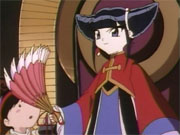 Lady Aska is the headstrong young ruler of Fahren, a magical world with a Chinese theme.
Lady Aska is the headstrong young ruler of Fahren, a magical world with a Chinese theme.
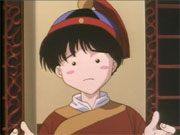 Sang Yung is Aska’s long-suffering personal assistant.
Sang Yung is Aska’s long-suffering personal assistant.
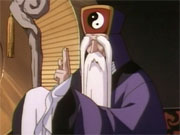 Chang Ang is Aska’s even-longer-suffering advisor and tutor.
Chang Ang is Aska’s even-longer-suffering advisor and tutor.
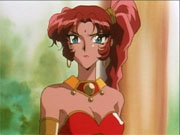 Tarta…
Tarta…
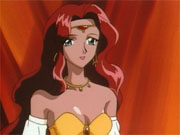 …and Tatra are princesses of Chizeta, a small magical world with an Arabian Nights theme.
…and Tatra are princesses of Chizeta, a small magical world with an Arabian Nights theme.

